 |
RETRO/NECRO:
From Beyond the Grave of the Politics of Re-Enactment
Text / Pil and Galia Kollectiv
Art in the period of its dissolution, as a movement of negation in
pursuit of its own transcendence in a historical society where history
is not yet directly lived, is at once an art of change and a pure
expression of the impossibility of change.
—Guy Debord, Thesis 190, The Society of the Spectacle1
 |
 |
|
Jo Mitchell, Concerto for Voice and Machinery II, March 20. 2007, performance (courtesy of the artist and the Institute of Contemporary Art, London)
|
The industrial noise engulfing the theater is not unpleasant. The crowd
stands back cautiously at first, then moves closer to better observe
the action of the men and women on stage, unable to decide whether to
enjoy the music or keep at the safe distance normally assumed by
visitors to re-stylized period rooms in European castles. The sound of
a coordinated group assault on the humble wooden floor of the Institute
of Contemporary Art [ICA] is almost like a well-preserved archival item
stored on a CD of twentieth-century sound effects, next to the rattle
of a film projector and the gentle clang of an analogue telephone.
Originally used by Einstürzende Neubauten when they performed here in
1984, the handheld industrial machinery is in itself already a
nostalgic signifier of the might of European manufacturing power,
crumbling under the new forces of globalization and financialization.
More than twenty years on, we are at Jo Mitchell's 2007 re-enactment of
Concerto for Voice and Machinery,
commissioned by the ICA's Vivienne Gaskin, who has been responsible for
a significant number of artists' re-enactments. With actors recreating
the postures, sounds, and ensuing mayhem of the German industrial
band's destruction of the venue that commissioned them, this feels like
looking back at what is no longer there—like the light from a distant
ancient star that, collapsed thousands of years ago, is still visible
in our sky. Planted, rioters in the audience begin to rip apart the
stage, already in tatters from the air drills and saws, apparently
causing security to put a stop to the proceedings. But of course the
link between cause and effect has been broken: the ICA guards are
equally fake, and it becomes hard to tell when the performance is
actually over, the entire event having been meticulously predetermined
by fragmentary surviving documentation of the original show.
Guy Debord's thesis number 190 concisely defines the
paradox at the heart of twentieth-century art practices—the demand for
an impossible permanent revolution, the mediation of an unmediated,
authentic experience, and the constant pull of both past and future,
progress and decadence. The recent spate of artists' re-enactments of
historical events and performances seems caught up in this dialectic,
haunted by Debord's paralyzing circular discourse. In his writing about
history and time, Debord claims that modern time, in the wake of the
domination of linear history, is subordinated to pseudo-cycles of work
and leisure. Fads, consumerist seasons, remakes, and retro fashions
are, in his view, imposed by capitalism on history. Are we therefore to
see artistic re-enactments as logical conclusions of the spectacle's
repetitive imperative? Or do they, in fact, form blockages in the
spectacle's seamless flows, exposing the construction of time within
its media and technologies? On the one hand, re-enactment suggests a
reactionary nostalgia for an idealized past where unmediated, live
experiences were possible—a reference that reifies performance,
aligning it with the demands of the market for reproducibility. On the
other hand, opposing this self-defeating narrative, re-enactment is
celebrated as a means of interrupting the march of time as progress and
of rewriting canonical history against the forces of power and capital.
This opposition can ultimately be traced back to modern debates around
originality and reproduction, but the problem with both approaches is
that they quickly degenerate into a battle for art's purity in which
work is either denigrated for its complicity with capitalism or
burdened with the mission of somehow bringing it down.

|
 |
|
Andrea Fraser, (Kunst Muss Hängen) Art Must Hang,
2001, DVD, 32:55 minutes (courtesy of the artist, Friedrich Petzel
Gallery, New York, and Galerie Christian Nagel, Köln/Berlin) |
Much of the recent discussion around re-enactments has centered on
projects in which artists have revisited old, undocumented performance
work: their own-as with Marina Abramovic's recreation of Seven Easy Pieces at the Guggenheim Museum, New York, and Carolee Schneeman's restaging of Meat
Joy
at Whitechapel Gallery, London—or others'—as in Andrea Fraser's
re-enactment of a Kippenberger speech and the Synthetic Performances of
Eva and Franco Mattes, a.k.a. 0100101110101101.ORG, which are
re-enactments of Joseph Beuys' 7000 Oaks, Chris Burden's Shoot, and Vito Acconci's Seedbed
on Second Life. According to Peggy Phelan, who is oft quoted in
relation to the subject, performance art is defined by its
singularity—for in being repeated or reproduced it becomes something
different. A double resistance—to capital and the technology that
subjects performance to its dictates—signifies what she calls "the
ontology of performance."2
In fact, art's performative turn, which goes all the way back to action
painting and its emphasis on the singular action of the painter, has
been theorized as a displacement of the auratic object: "The artist
stepped (or danced) into the place of the object and rescued origin,
originality, and authenticity in the very unrepeatable and
unapproachable nature of his precise and human gesture-his solo act."3 Of course, as Philip Auslander writes in response to such claims, the liveness of performance can only ever be
conceptualized in relation to the possibility of recording:
the live and the mediatized exist in
a relation of mutual dependence and imbrication, not one of opposition.
The live is, in a sense, only the secondary effect of mediating
technologies. Prior to the advent of those technologies, e.g.
photography, telegraphy, phonography, there was no such thing as the
"live," for that category has meaning only in relation to an opposing
possibility. Ancient Greek theatre, for example, was not live because
there was no possibility of recording it.4
But it is precisely the tension between liveness and
mediation that seems to be attracting contemporary artists to classic
performances, salvaging from their meager documentation a script from
which to ask questions about authenticity and originality. As Mark
Cameron Boyd points out in his article, "Performance Simulacra:
Reenactment as (Re)Authoring," this logic can quickly lead to a dead
end:
It is this denial of the original, this re-casting of
previously enacted performances as "new experiences," that introduces
the final thorny summation of reenactments like Abramovic's as weak
copies, drained of their specific time-based authenticity, that
transform performance into vapid simulacra to re-place
the real Being of the original.5



|
 |
|
Iain Forsyth + Jane Pollard, production still from File under Sacred Music, 2003, projection with sound, 22 minutes (courtesy of the artists and Kate MacGarry, London)
|
Despite these accusations of a weakened, slight return aiding the
commodification of the supposedly uncommodifiable, many attempts have
been made to valorize re-enactments as a critical practice, in
exhibitions like A Little Bit of History Repeated [Kunstwerke, Berlin; 2001],
Life, Once More [Witte de With, Rotterdam; 2004], Re- [Site Gallery, Sheffield; 2007] and most recently History Will Repeat Itself:
Strategies of Re-Enactment in Contemporary (Media) Art and Performance
[Hartware MedienKunstVerein (HMKV), Dortmund, and Kunstwerke, Berlin;
2007], in artists' projects—such as Jo Mitchell's and Iain Forsyth
& Jane Pollard's re-enactments of popular music concerts—and in a
series of debates, articles, and panel discussions, including the Art
And Re-Enactment Conference at The Australian National University in
Canberra. A question recurs in this context: on what grounds can we
differentiate critical—and therefore "good"—re-enactments from those
that simply rely on the familiarity of established art to launch new
careers or cash in on previously immaterial art? Or, as Melanie
Gilligan writes in her essay on performance and its appropriations,
"Which practices involving re-enactments might be retrograde
withdrawals from new aesthetic and political struggles, and which
others are catalysts for them?"6

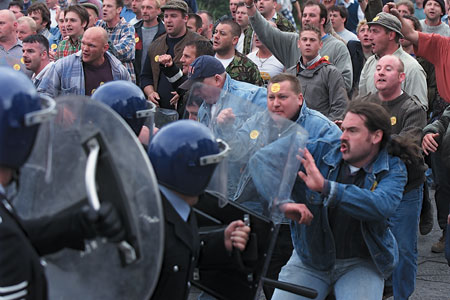
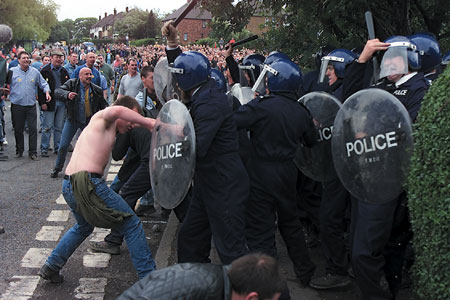
|
 |
|
Jeremy Deller, stills from The Battle of Orgreave, DVD, 2001, 62:37 minutes (directed by Mike Figgis; commissioned and produced by Artangel, London; photo: Martin Jenkinson)
|
Against the Debordian pseudo-cyclical time produced by trite Hollywood
remakes, Sven Lütticken suggests that art might be better able to
tackle reiteration as a form of critique: Perhaps the peculiar economy of the art world makes it a
more suitable sphere for the realization of remakes that resist the
dominant culture of repetition. But wherever it originates, the hope
held out by the remake lies in the liberation of the dormant
possibilities of mass culture—its utopian potential. The vicious circle
of standardized remake production—its frozen movement of mythical
signs&mash;needs to be derailed. It is intrinsic to these signs
that such a practice is possible. The myths of the media themselves
harbour a potential to generate second-degree myths that offer glimpses
of what Barthes called a "true mythology," in which myth is fleetingly
transformed by reason and history.7
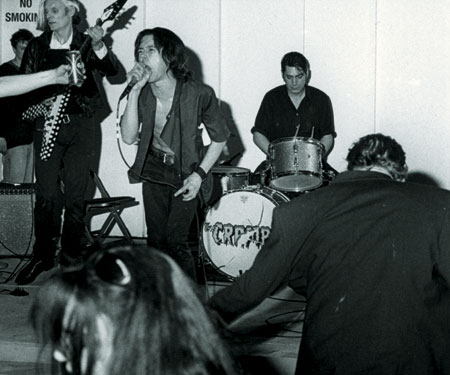

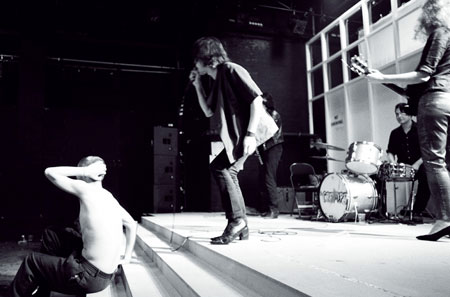
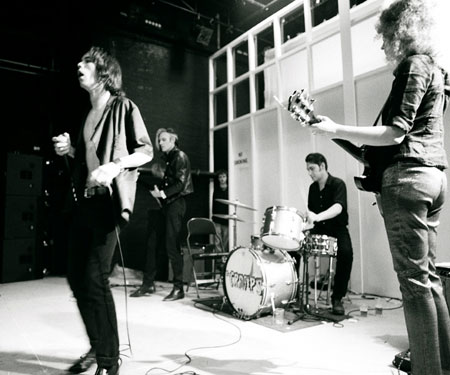
|
 |
|
Iain Forsyth + Jane Pollard, production still from File under Sacred Music, 2003, projection with sound, 22 minutes (courtesy of the artists and Kate MacGarry, London)
|
The desire to liberate mass culture's utopian potential seems to lie at
the heart of many artistic re-enactments. Jo Mitchell was hoping that
the re-enactment of Concerto might "create a rupture in our
viewing and witnessing in relationship to the idea of the authentic
experience and in this sense challenge what might be seen as an
apathetic consumption of experiences." The need to reexamine and
question passive consumption of ideas and historical narratives unites
many re-enactment projects. Jeremy Deller's The Battle of Orgreave,
2001, one of the progenitors of this strategy, famously revisited the
miners' conflict with Thatcher's police forces with the intention of
reinserting the miners' perspective, originally vilified in the press,
into history. Iain Forsyth & Jane Pollard, who have produced
several re-enactments including the last performance of David Bowie as
Ziggy Stardust and the Cramps' gig at the Napa asylum, have claimed
that it is the gap between the reproduction and its point of origin
that cuts through the mediation to reveal the real and subvert the
logic of the spectacle: it's rarely the event or action being repeated that we're
interested in reconsidering. Repetition works like a catalyst, and it's
our relationship to the imitation and the act of creating and
witnessing the "copy" where something interesting happens. Failure is
hugely important to us, and understanding its importance is vital to
our work. Copying anything, the copy never reproduces the original
completely. And this shortfall is where the real emerges, where
understanding can begin. Good art always, at some level, fails.8
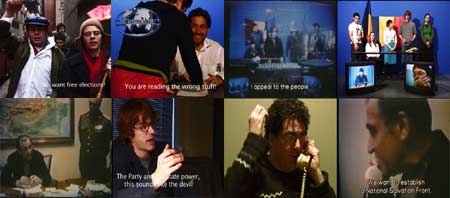
|
 |
|
Irena Botea, stills from Auditions for a Revolution,
2006, video installation, mini-DV and 16mm film on mini-DV, transferred
to DVD, 22 minutes, English and Romanian (courtesy of the artist) |
At Dortmund's HMKV, as part of the exhibition History Will Repeat Itself: Strategies of Re-Enactment in Contemporary (Media) Art and Performance,
Forsyth & Pollard's File Under Sacred Music,
2003, a video of contemporary musicians performing as the Cramps to a
mentally disabled audience replicating the bizarre occasion at the Napa
Mental Institute in California, shares a noisy space with Deller's film
and a host of other—mainly video—works looping repetitions of
historical instances and commentaries on the appropriation of the past.
American students rehearse a revolution that has already been
televised, reading out transcripts in a language they do not speak
alongside original footage from Romania, 1989, in Irina Botea's Auditions for a Revolution, 2006. Felix Gmelin's Farbtest, Die Rote Fahne II, 2002, reconstructs Gerd Conradt's film Farbtest, Die Rote Fahne,
1968, of a relay run of young men carrying a red flag through Berlin,
in which his father participated, this time transposed to a far less
radicalized Stockholm.
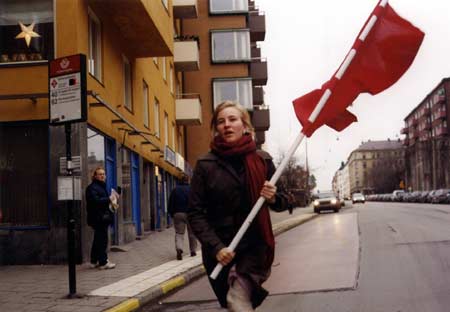

|
 |
|
Felix Gmelin, stills from Farbtest, Die Rote Fahne II,
2002, 2-channel video installation, 12 minutes, silent (courtesy of the
artist, Maccarone Inc., New York, and Milliken, Stockholm; producers:
Felix Gmelin, Anna Sohlman, and Hinden/LännaAteljéerna AB; photo:
Tobias Sjödin)
|
In The Eternal Frame,
1975, T. R. Uthco & Ant Farm refilm Kennedy's assassination, this
time with the president's full awareness of his status as a media
image. The selections avoid the obvious Abramovic/Acconci/Schneeman
references in favor of a wider exploration of the subject. Curator Inke
Arns explains:
We decided not to include artists performing or re-enacting
performances from the 70s for example. This has been done in shows
quite a few times already and content-wise we wanted to concentrate on
artists repeating historical events. It was about how we relate to
history and how it is conveyed or mediated to us. The question of media
is very important. We are moving forward in time and, depending on our
position in time, history becomes readable in a different way. In the
last five or ten years, there has been a growing interest in the
strategy or logic of re-enactment, which means taking things out of
history books and making them happen again to allow for a different
kind of experience that is neither reading nor looking at images. It
has to do with the fact that, in a media-saturated society, you are
more and more unable to relate to what's been going on.9
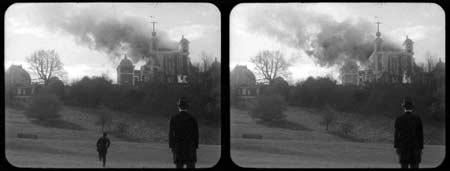
|
 |
|
Rod Dickinson + Tom McCarthy, Film
Still: Greenwich Observatory, approx 4pm, Feb 15th, 1894 and Martial
Bourdin depicted in The Sun, Saturday Feb 17th, 1894 from Greenwich
Degree Zero, 2006, installation, including film footage
(reconstruction: Royal Observatory, Greenwich Park, London), 15 tables,
15 lamps, 30 chairs, archival materials, photographs, video (courtesy
of the artist) |
There is a danger in this reading of re-enactments as engines of
criticality, which deals mostly with questions of commodification (of
art practices and historical moments), or of spectacle and simulation,
and ultimately relies on the very categories that are used to condemn
supposedly facile remakes. We run the risk of reducing re-enactments to
a list of collaborators and resistors of capitalism and its
institutions: artists either produce passive spectators obeying the
pseudo-cyclical logic of the market or emancipate their viewers from
the hold of the media and its narratives by short-circuiting its fake
cycles. Whether we single out unrealized utopian moments and rewrite
them as successes—as in Rod Dickinson and Tom McCarthy's Greenwich Degree Zero,
2006, a re-enactment of the failed bomb attack on Greenwich
Observatory, also on view at HMKV—or failures—as in Forsyth &
Pollard's flawed reconstructions of mythical performances, we could
find ourselves forever stuck within Debord's "art of change and a pure
expression of the impossibility of change." However, as Jacques
Rancière has maintained, this is only because, in insisting on this
relationship between performance and politics, we are making
contradictory demands:
the equivalence of theater and community, of seeing and passivity, of
externality and separation, of mediation and simulacrum; the opposition
of collective and individual, image and living reality, activity and
passivity, self-possession and alienationŠmakes for a rather tricky
dramaturgy of guilt and redemption. Theater is charged with making
spectators passive in opposition to its very essence, which allegedly
consists in the self-activity of the community. As a consequence, it
sets itself the task of reversing its own effect and compensating for
its own guilt by giving back to the spectators their self-consciousness
or self-activity.10
When we renounce this idea that there is a truth and a corresponding
politics to be uncovered once the spell of the spectacle is broken,
subtler distinctions in terms of the temporal play involved in
re-enactments come to the fore. Following Nietzsche's "Untimely
Meditations," Michel Foucault opposes history and genealogy: unlike the
supposed scientific objectivity of history, which seeks to trace the
inscription of a "point of origin" which "comes before the body, before
the world and time"11 on the present, genealogy is
concerned not with the birth, but with the emergence of regimes of
knowledge. Rejecting the notion of origin of historical moments,
Foucault's genealogy privileges the accidents, the coincidences, and
the ironies that inscribe time with meaning. Within this framework, a
historical moment is never new, which means that there is no original
to repeat. A successful re-enactment would therefore simply expose this
historical moment to a whole new set of "haphazard conflicts" that
ultimately produce a "true historical sense [that] confirms our
existence among countless lost events, without a landmark or a point of
reference."12
This disloyalty to the point of origin does not amount to historical
relativism, but rather activates history from within the present,
allowing us to move away from the sterile attempt to cut through the
infinite mediations of the spectacle. This is also where, as Inke Arns
observes, artistic re-enactments diverge from historical re-enactments
of famous battles:
If you see the show in the context of popular re-enactments (as in
medieval villages or civil war battles), the artists here deal with
real history that has to do with life today. The pieces in the show,
despite dealing with historical events, are never nostalgic because,
unlike popular re-enactments that don't make a connection to yourself
and your time, the works here deal with twentieth-century events and
make a very direct connection to your role in them.
For Rod Dickinson,
the specific historical point of origin of these works is
important, but primarily because it can offer a play of interpretation
and create a discourse around the idea of historical representation.
Perhaps this is rather different from a more relativist approach where
the point of origin might not be seen as important as the
interpretation. The audience is presented with something inherently
contradictory in that they are being presented with something live and
happening in real time, yet they know that this is an impossible
scenario, since the event has already happened, and they know the
outcome (in most of my events/work the audience is given information
sheets that tell them what happened). Their "live" experience is
constantly undermined by knowledge about what they are watching (or
participating in), which is prescribed and is being carefully re-staged.13
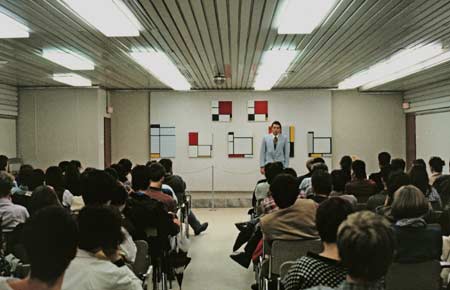
|
 |
|
Walter Benjamin, Mondrian '63-'96, 1987, video, transferred to DVD, 25 minutes, English with Serbo-Croatian subtitles (© Museum of American Art)
|
Elsewhere at HMKV, housed in the great hall of the spare-parts
warehouse of the disused neighboring factory, Walter Benjamin,
resurrected in 1987, lectures on the value of Mondrian copies, arguing
that they are more complex than the originals. This Benjamin's
compatriots, Slovenian art and music project Laibach, have long been
proponents of the "Monumental Retro-Avantgarde," whose founding
manifesto states: "We proclaim that copies have never existed and we
recommend painting from pictures painted before our times. We claim
that art cannot be judged from the viewpoint of time. We acknowledge
the usefulness of all styles for the expression of our art, those past
as well as present."14 This
insistence on "usefulness" seems to resonate with the notion of
"effective history" that Foucault borrows from Nietzsche. In his book
about Laibach and the NSK collective, Alexei Monroe sees in this
retrogardism an opportunity to "unfreeze" the situation, "enabling
disruption, change and reformation. Yet," he continues, "this is not an
avant gardist attempt to construct a new future based on negation of
the past. Rather, retrogardism attempts to free the present and change
the future via the reworking of past utopianisms and historical wounds."15 This idea is perhaps most cruelly demonstrated in Artur Zmijewski's 80064, 2004, in which
an Auschwitz survivor is persuaded to have his tattoo refreshed, the present literally overwriting the past.
It is this emphasis on the present that differentiates much of the work included in History Will Repeat Itself
from other forms of bringing history to life. Whereas historical
dramatization tries to visualize the unknown and unknowable, imagining
the detail of unfilmed battles or putting words in the mouths of famous
leaders to produce biographies and historical epics, artistic
re-enactments often limit themselves to the known, however partial,
filling in the gaps to produce a genealogy of current conditions. To an
extent, these re-enactments are preoccupied with a question of scale.
Earlier this year, at the Materialism Today conference at Birkbeck University, Slavoj
Zizek posited the ontological incompleteness of reality, which, like
the unrendered interior of an unexplored house in the background of a
videogame, is not determined to a point beyond the atom. Magnifying the
past beyond the point we know to be determined by historical
documentation, we arrive at a similar cul-de-sac where we quickly have
to fill in the pixels. This may point to a radical shift in our
perception of history in the digital age. If the most significant sites
of recent history have operated thus far as invisible black holes (from
Nazi death camps to Tiananmen Square and Guantánamo Bay), we
increasingly assume that the past is subject to total access. A
reconfiguration of the search parameters or a digital zoom at a higher
resolution are all it takes not to get to the truth of an event, but to
actually participate in historical events such as the recent open call
for a Google Earth search after lost pilot Steve Fossett.
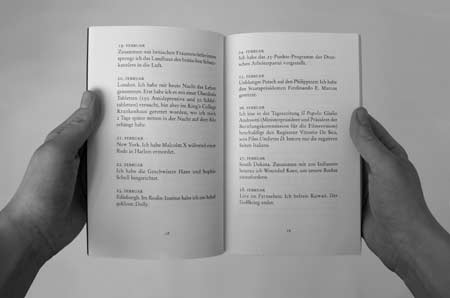
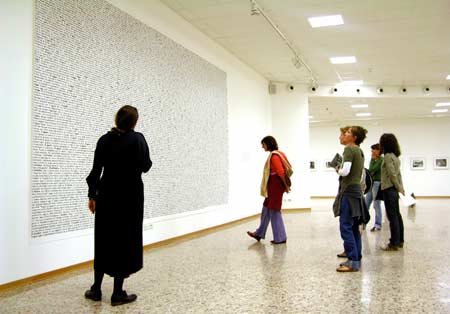 |
 |
|
top:Daniela Comani, Ich war's. Tagebuch 1900-1999, 2005, book project for Revolver-Archiv für aktuelle Kunst (courtesy of the artist);
bottom:
Daniela Comani, Ich war's. Tagebuch 1900-1999, 2006, installation, digital print on net vinyl, 300 _ 600 cm (courtesy of the artist)
|
As artists appropriate more moments for themselves, they will not be
reclaiming them from the media as such, but rather producing their own
private mediatizations, turning them into individual experiences for
their viewers. This shift will require us to move away from an
understanding of repetition as technical reproduction, for the
repetition of an act, unlike the reproduction of an object, does not
diminish its cult value, as the real Walter Benjamin wrote in 1936.
Instead, this repetition turns event into private ritual, an idea born
out by Tom McCarthy's pivotal novel of re-enactment, Remainder, included in part in the catalogue of
History Will Repeat Itself, in which, following an accident, the
protagonist finds himself compelled to repeat increasingly violent
events with the aid of paid actors and staff-the repetition heightening
his sense of an otherwise dim presence in the here and now. Like
Zmijewsky's film, McCarthy highlights the potential for sadism within
the framework of the re-enactment and the power relations produced in
taking ownership of history. In Daniela Comani's installation, Ich War's. Tagebuch 1900-1999,
2006, the artist reports her presence in the first person at every
significant event of the twentieth century, becoming history. Writing
about the relationship performance produces to the past, Joseph Roach
has employed the metaphor of a necrophilic impulse, seeking "to
preserve a sense of the relationship to the past by making physical
contact with the dead."16 In exhuming these raw
data corpses, reordering and staging them as actors in new old plays,
contemporary art is writing its own genealogy, in which private,
individualized, unofficial versions compete for cultural space in the
public sphere.
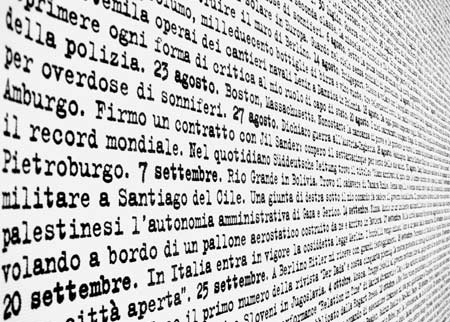
|
 |
|
Daniela Comani, Ich war's. Tagebuch 1900-1999, 2006, installation, digital print on net vinyl, 300 _ 600 cm (courtesy of the artist)
|
NOTES
1. Guy Debord, The Society of the Spectacle, Donald Nicholson-Smith, tr., New York: Zone Books, 1995, originally published in French in 1967.
2. Peggy Phelan, Unmarked: The Politics of Performance, London: Routledge, 1993, 146.
3. Rebecca Schneider, "Solo Solo Solo," in After Criticism: New Responses to Art and Performance, Gavin Butt, ed., Oxford: Blackwell, 2005, 33.
4. Philip Auslander, "Liveness," in Performance and Cultural Politics, Elin Diamond, ed., London: Routledge, 1996, 198.
5. Mark Cameron Boyd, "Performance Simulacra: Reenactment as (Re)Authoring," Theory Now, 2007, at: http://www.theorynow.blogspot.com/2007/05/performance-simulacra-reenactment-as.html, accessed September 30, 2007.
6. Melanie Gilligan, "The Beggar's Pantomime: Performance and its Appropriations", Artforum, Summer 2007, 429.
7. Lütticken, Sven, "Planet Of The Remakes", New Left Review 25, January-February 2004, 119.
8. Iain Forsyth + Jane Pollard, all quotes from conversation with the authors, September 2007.
9. Inke Arns, all quotes from conversation with the authors, September 2007.
10. Jacques Rancière, "The Emancipated Spectator," Artforum, March 2007, 274.
11. Michel Foucault, "Nietzsche, Genealogy, History," in: Language, Counter-Memory, Practice: Selected Essays and Interviews, Donald F. Bouchard and Sherry Simon, tr., Oxford: Blackwell, 1977, 143.
12. Ibid., 154-5.
13. Rod Dickinson, email to the authors, September 2007.
14. Alexei Monroe, Interrogation Machine: Laibach and NSK, Cambridge, MA: MIT Press, 2005, 53.
15. Ibid., 120.
16. Joseph Roach, "History, Memory, Necrophilia", in The Ends of Performance, Peggy Phelan and Jill Lane, eds., New York: New York University Press, 1998, 29.
Contributing
Editors Pil and Galia Kollectiv are London-based artists, writers, and
independent curators. Their essay "Militant Ironies: Art as a Strategic
Weapon in Israel's Culture Wars" was published in ART PAPERS 30:05
(September-October 2005).
|

![]()
![]()